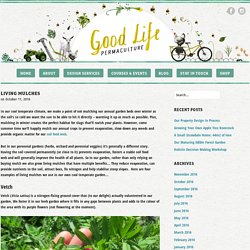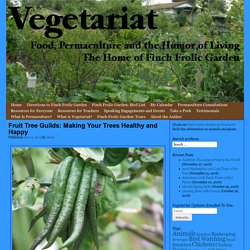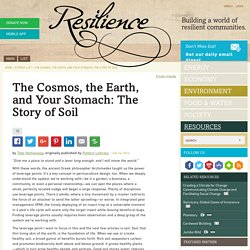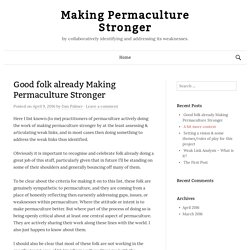

Good Life Permaculture. In our cool temperate climate, we make a point of not mulching our annual garden beds over winter as the soil’s so cold we want the sun to be able to hit it directly – warming it up as much as possible.

Plus, mulching in winter creates the perfect habitat for slugs that’ll ravish your plants. However, come summer time we’ll happily mulch our annual crops to prevent evaporation, slow down any weeds and provide organic matter for our soil food web. But in our perennial gardens (herbs, orchard and perennial veggies) it’s generally a different story. Having the soil covered permanently (or close to it) prevents evaporation, fosters a stable soil food web and will generally improve the health of all plants. So in our garden, rather than only relying on buying mulch we also grow living mulches that have multiple benefits… They reduce evaporation, can provide nutrients to the soil, attract bees, fix nitrogen and help stabilise steep slopes.
A nasturtium creeper beneath our young medlar tree. Fruit Tree Guilds: Making Your Trees Healthy and Happy. An unripe Buddha’s Hand citron.

Book Review: The Scoop On Poop. The Dr.

Pooper Papers, Issue #4: If you know of the name Dan Chiras, then you've probably heard it in reference to the multitude of books he's written on alternative energy sources, alternative building methods, and more. But as important as his previous works have been, his latest book, on an alternative food source, is probably his most important yet. Yes, for those who already know what his latest book is about (and/or just saw the cover shot accompanying this post), I did just say "alternative food source. " The Cosmos, the Earth, and Your Stomach: The Story of Soil. “Give me a place to stand and a lever long enough, and I will move the world.”

With these words, the ancient Greek philosopher Archimedes taught us the power of leverage points. Piecing Together a Guild of Your Own. Photo: Panorama (Courtesy of hardworkinghippy) In the scheme of permaculture food production, harnessing the most out of nature whilst using its own attributes, creating plant guilds ranks pretty high up there.

Most of us know them in simplified forms such as the three sisters—corn, beans and squash—or companion plantings like carrots and onions or tomatoes and basil. Companion Planting for Vegetables - Very Edible Gardens. What if everyone around you was exactly like you?

That sounds to me like some kind of perfect hell. Companion Planting for Vegetables - Very Edible Gardens. 25 hardy plants for your permaculture vegetable garden. Native raspberry It is high in antioxidants and it studies with mice was shown to prevent damage to the liver.

Similar taste to commercial raspberries Hardier in this climate than commercial raspberries, can be shawn off at the base whilst in leaf and resprout within weeks (It was accident, but it came back even bushier!) Self-fertile, but more success by layering – takes root where canes touch the ground Tolerates full sun to full shade, but more likely to fruit with sun exposure. Rocket. Forum: Living Mulch.
Bill Mollison Permaculture Lecture Series On-Line. Straw Bale Construction Straw bale construction is gaining worldwide recognition as a viable, high-performance, earth- and people-friendly building technique which utilizes a natural by-product of food production.

The Straw Bale Solution is 30-minute video introduction to straw bale building. Good folk already Making Permaculture Stronger. Here I list known (to me) practitioners of permaculture actively doing the work of making permaculture stronger by at the least assessing & articulating weak links, and in most cases then doing something to address the weak links thus identified.

Obviously it is important to recognise and celebrate folk already doing a great job of this stuff, particularly given that in future I’ll be standing on some of their shoulders and generally bouncing off many of them. To be clear about the criteria for making it on to this list, these folk are genuinely sympathetic to permaculture, and they are coming from a place of honestly reflecting then earnestly addressing gaps, issues, or weaknesses within permaculture. Permaculture’s Dogma Problem – Liberation Ecology. Not too long ago, two of our most internationally renowned permaculture teachers/consultants had some vigorous disagreement on social media.

Hordes of commenters weighed in on either or neither side. The explicit topic of the disagreement was the value of contour ditches – known in permaculture as ‘swales’ – for managing water in the landscape. Are they (A) a universal solution for every landscape? The Perma Pixie - Passionate Education and Earth Regeneration. How to Break a Broody Hen. It seems I've been answering this question a lot lately, so I thought I'd write it all up to better show up in a search on the subject. Please feel free to add your wisdom to the topic. The Permaculture City: Cities as Complex Systems. The following sections are excerpted with permission from Chapter 1 of Toby Hemenway's new book The Permaculture City, published by Chelsea Green. Design Basics: Mapping the Sun on your Site.
June 1, 2015 | Design, Permaculture, Permaculture Design | 6 Comments | Author: Nick Ritar.